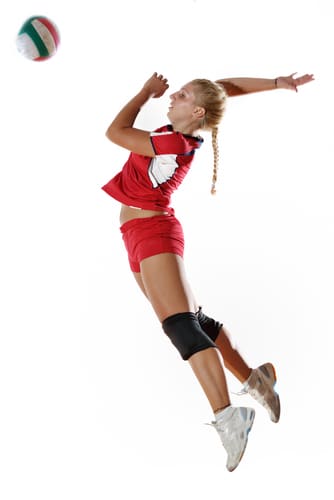
Research has identified a number of reasons why women are at four times greater risk for ACL injury. These include different hormonal influences and the fact that women have smaller ACLs relative to men. Now a new study published in the Journal of Athletic Training points out another reason – women land differently when they jump than men.
ACL Injuries in Women – Why They’re at Higher Risk
Researchers from the University of North Carolina at Chapel Hill and Oregon State University used motion analysis software to look at how 82 physically fit men and women land when they jump. They found women were more likely than men to land in a “knock-kneed” position. Landing in this position places greater stress on the ligaments that stabilize the knee and increases the risk for an anterior cruciate ligament tear. Women land also more “stiffly” with less “give” in their knees. Women who participate in sports that involve jumping or pivoting like basketball, soccer and volleyball are at greater risk for an ACL tear.
Another reason women are at greater risk for ACL tears are differences in anatomy. The anterior cruciate ligament runs through the compartment between the condyles of the femur bone. This compartment is narrower in women. As a result, the ligament can be pinched or squeezed, especially with twisting motions. This puts greater stress on the ACL and increases its risk of tearing. Yet another anatomical difference puts women at greater risk for ACL injuries. Women have a wider pelvis than men. As a result, their tibia meets their femur at a greater angle. This places added stress on the ligaments.
As you can see, women are at an anatomical disadvantage when it comes to knee stability. Another problem is women have less muscle strength in their thighs relative to the underlying bone. Plus, women typically have greater strength in their quadriceps relative to their hamstrings. Greater strength in the quadriceps relative to the hamstring muscles places added stress on ACL ligaments.
What Can You Do to Protect Your Knees?
One way to lower your risk for an ACL tear and knee problems, in general, is to strengthen and condition your thigh muscles with a special emphasis on hamstring strengthening to decrease the strength discrepancy between the quadriceps and hamstring muscles. Squats and lunges, using good technique, are among the best for strengthening the muscles in your thighs.
Secondly, work on your technique when landing from a jump. Land with your knees pointing forward with knees bent – not straight and rigid. Practice landing softly. Watch your form in a mirror or have someone critique your landings until you get it right.
Add balance exercises to your routine. Do single leg squats and lunges to improve strength and balance. This is especially important if you play sports. Agility drills are also helpful for increasing dynamic stability.
Add plyometric drills to your routine. Squat jumps and standing jumps provide an opportunity to improve your form when landing. Research shows training programs that include high-intensity jumping exercises lowers the risk of ACL tears.
Improve core strength. When you have better trunk control and greater core stability, it reduces the stress on your knees. A study among alpine skiers, a group at high risk for ACL tears, found that core strength imbalances are a risk factor for ACL tears.
The Bottom Line?
The road to recovery from an ACL tear is a long one. Once you’ve torn an ACL, you’re at greater risk for osteoarthritis. Women are at higher risk for men due to the factors mentioned. Reduce your risk by learning how to land properly when you jump and work on strengthening your quadriceps, hamstrings, and core.
References:
Medical News Today. “Women More Likely to Tear ACL Due to Knock Knees”
Robert McAlindon, M.D. “ACL Injuries in Women”
Up to Date. “Anterior Cruciate Ligament Injury”
Br J Sports Med 2011;45:310-311 doi:10.1136/bjsm.2011.084038.3
ACL Injuries in the Female Athlete 2012, pp 169-183.
Br J Sports Med. 2012;46(15):1065-1071.
Curr Opin Orthop. 2005 October; 16(5): 354-362.
Related Articles By Cathe:
Sports Injuries in Women: Why Women Are at Greater Risk for ACL Injuries

